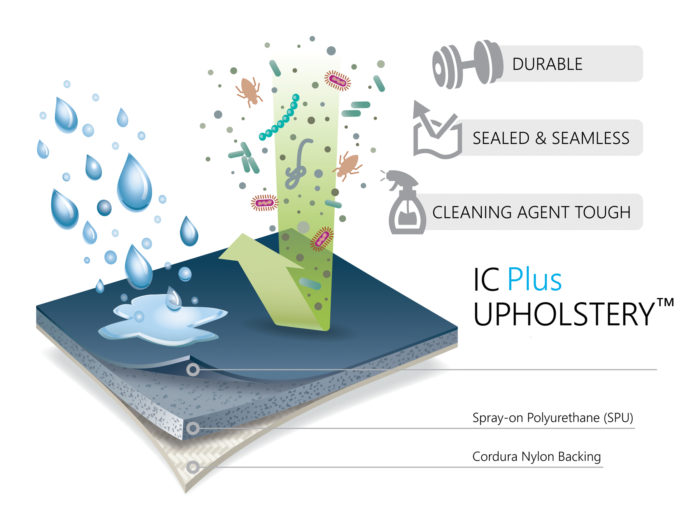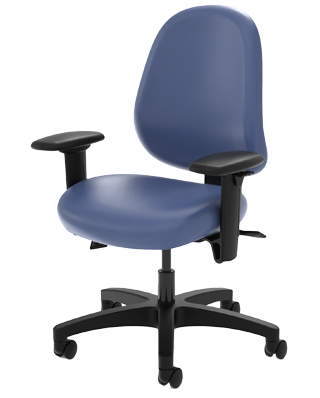Efficacy of Antimicrobials for Infection Control
Over the past two decades healthcare professionals, and the world at large, have become increasingly concerned with the spread of anti-bacterial resistant “super bugs”. This concern is fueled by the constant flow of information describing the spreading virulence associated with MSRA, H1N1, and other pathogenic outbreaks occurring around the world. With the increased presence of these known “super bugs”, along with the increased prevalence of healthcare associated infections, the health care industry has invested a lot of resources in preventative medicine and infection control.

These measures are not only in the interest of potentially saving millions of lives, but also, a reduction in hospital-acquired infections would potentially save billions of dollars annually in health care costs. Thus, recently there has been increased interest in a variety of technologies to help minimize these infections. One such technology has been the introduction of heavy metals into furnishings to reduce dry surface contamination in healthcare settings. These heavy metals, such as copper and silver, are known to have anti-pathogenic properties. In fact, they have been used for hundreds of years in such areas as wound dressings and water filtration systems. However, these heavy metals exhibit varying efficacy and require optimal conditions for their anti-pathogenic actions.
Antimicrobial Agents
Antimicrobial agents are being introduced into high-frequency touched items, such as doorknobs, handles and dry furniture surfaces, in order to reduce the ability of pathogens to grow and survive on touch surfaces. Silver-ion is a fairly recent advancement utilized by furnishing companies as an antimicrobial agent. Several furniture manufacturers utilize textiles with a silver-ion additive, advertised to the healthcare industry as being able to “inhibit the growth of mold, mildew, and other microorganism.” Vinyl fabrics with silver-ion imbedded in the material are advertised as “a long-lasting, safe, broad spectrum antimicrobial technology that actively targets microorganisms and bacteria on the protected surface of the upholstery.” A minimally antimicrobial fabric, such as vinyl, acts as a moisture barrier with the silver ions embedded inside the upholstery. Third party textile manufacturers synthesize these fabrics with silver-ion embedded inside. Both parties neglect to provide evidence in support of the ability of silver-ion to be an effective antimicrobial agent in a “real-world” hospital setting.
The study concluded that in order for silver-ion to be an effective antimicrobial agent, the surface must have a relatively high amount of moisture, one that points to ionic silver having no place as a useful antimicrobial agent on a dry touch surface.
Silver-ion Efficacy
There is a significant amount of promotion of silver-ion becoming more widely utilized in healthcare settings. Funding for research that attempts to demonstrate the anti-pathogenic properties of silver-ion tries to bias the reader. However, this research is not truly representative of silver-ion’s ability as an antimicrobial agent in clinical settings. An August 2009 study, published in ‘Letters in Applied Microbiology’, illustrated the lack of information of silver-ion’s efficacy. Previous to this study, silver ion’s efficacy as an antimicrobial agent was only observed under the Japanese Standard; ie. silver ion tested for 24 hours under the environmental conditions of 90% relative humidity at 35 °C. The study, conducted by Dr. Michels, et al, tested silver ion on a dry surface under two environmental conditions for 24 hours; firstly at the Japanese Standard conditions, and then at 22% relative humidity and 20°C, a normal ambient environment representative of a hospital setting. The samples were then contaminated with MSRA, a deadly bacterium, commonly present in hospitals. The results indicated that silver-ion is only effective against MSRA under conditions representative of a tropical rainforest (>90% relative humidity and 35 °C.). Conversely, when conducted under normal conditions silver ion’s efficacy against MSRA showed no significant reduction in bacterial count.
The study concluded that in order for silver-ion to be an effective antimicrobial agent, the surface must have a relatively high amount of moisture, one that points to ionic silver having no place as a useful antimicrobial agent on a dry touch surface. Thus most of the research following 2009 focused on demonstrating silver ion’s efficacy in an aqueous solution, in such products as disinfectants or wound dressings, conditions in which silver ion displays some antimicrobial action. Thus, silver-ion containing materials are unable, under the EPA, to make relevant health claims concerning their products. As well with the continually increasing price of silver, mostly driven by the increased utilization of silver in technology over the past 20 years, the use of this metal is becoming less attractive.
IC Plus™ Infection Control Technology

The integration of heavy metals into upholstery is not the only innovation in furniture manufactured for emergency rooms, operating rooms, and patients’ areas. healtHcentric’s IC Plus technology is an recent innnovation that solves many of the issues of healthcare furniture. When you walk into a crowded downtown hospital, the first thing you notice is the plethora of cracked vinyl chairs in the waiting areas. Cracked vinyl presents a greater danger in an area like a hospital waiting area, where there is a high potential for the spread of pathogens, like fungi and bacteria. The cracked vinyl is a “hotbed” for bacterial growth as disinfectants would likely not be able to reach inside the cracked vinyl; as well temperature and moisture content would be favorable for bacterial colonization.
In an independent laboratory study it was proven that, when used in tandem with hospital-grade cleaners, it is possible to remove 98.68% of the microorganisms–equivalent to a 3 log reduction–from the IC Plus Upholstery. This far exceeds the 58.08% removal of microorganisms– equivalent to a 0.4 log reduction–from seamed healthcare grade vinyl.
IC Plus Upholstery is an answer to these issues. IC Plus is a PVC-free polyurethane material, a strong durable material unmatched by healthcare vinyl.
IC Plus is completely seamless, meaning that the seating boasts a moisture-free barrier. This barrier is not just impenetrable to moisture, but also inhibits the ability of fungi and bacteria and bed bugs to colonize the interior of the seat cushion. The seamless and non-porous nature of IC Plus also makes it easy to clean, and the entire seating surfaces can be quickly and effectively cleaned with hospital-grade disinfectants including bleach, CaviCide, WexCide, Virox 5, and Rescue, which are commonly used in a hospital settings. In fact, independent testing clearly illustrates IC Plus outperforming vinyl in a multitude of areas.
Durability is the Key
With the infection control risks that cracked vinyl surfaces present in high traffic areas, the durability to resist hospital-grade cleaning agents and prevent seating surfaces from cracking has been proven to be the most effective strategy to prevent infection control issues in vulnerable high traffic areas. In an independent laboratory study it was proven that, when used in tandem with hospital-grade cleaners, it is possible to remove 98.68% of the microorganisms–equivalent to a 3 log reduction–from the IC Plus Upholstery. This far exceeds the 58.08% removal of microorganisms– equivalent to a 0.4 log reduction–from seamed healthcare grade vinyl.
In terms of durability and strength, IC Plus with its advanced polymer technology is far superior compared to healthcare vinyl. A puncture test comparison showed IC Plus being almost 10 times stronger than vinyl, able to withstand 262 lbs. of pressure as compared to 31 lbs. for vinyl. IC Plus also outperformed in durability testing, able to withstand over 2000 cycles of abrasion testing with a wire screen, while exhibiting no change in the look and durability of the material. Contrary to this, vinyl’s appearance started to change after only 500 cycles. IC Plus’s ability to be extremely durable, coupled with its seamless impenetrable surface, makes it a superior choice for utilization in any healthcare environment.
Michels, H., Noyce, J., & Keevil, C. (2009). Effects of temperature and humidity on the efficacy of methicillin-resistant Staphylococcus aureus challenged antimicrobial materials containing silver and copper. Letters in Applied Microbiology, 49(2), 191–195.
http://www.ncbi.nlm.nih.gov/pmc/articles/PMC2779462/


